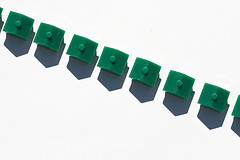
Posted on 09 January 2012. Tags: Fixed rate mortgage, Floating interest rate, Freddie Mac, interest rate, loan, Mortgage loan, Refinancing
Pros of a 30-Year Fixed Mortgage
With interest rates at a historical lows, consumers are racing to refinance their homes. In many cases consumers reach for the traditional 30-year mortgage. This loan locks in the incredibly low rates we see today for thirty years and in most cases gives the consumer a much lower payment than they had before. This sounds great because with rate where they are there is not much lower they can go and certainly over the next 30 years we should expect rates to rise perhaps even dramatically if inflation were to rear its head. It certainly sounds like the 30 year fix mortgage is a great alternative to any adjustable rate loan offer that will most likely result in higher payments and interest to consumers in the future.
Wow! Look at the Interest You Pay over 30 years
What many consumers don’t realize is just how much they pay in interest over the term of their loan. Let’s take a $100,000 loan at 4.25% interest rate (Interest rates will vary based on credit and other factors). Over the 30 year term you pay $77,098 in interest on top of the $100,000 you borrowed. That is a 77% premium to your original loan amount. If we take a bigger loan say $625,000 you end up paying a whopping $481,250 in interest which is the same 77% premium to your original loan amount.
The 15-Year Fixed Mortgage – A Simple Trick
Now if you don’t like the idea of paying your bank all that interest here’s a simple solution. Consider a 15 year fixed mortgage. There are two big advantages to a 15 year fixed mortgage. First, the term is half as long so you will pay less interest because of this time element. Second, many lenders offer lower rates on 15 year fixed mortgages so you will pay less interest because of the lower rate. Let’s go back to our examples. The $100,000 loan for 15 years now has an interest rate of 3.4% (Again interest rates will vary based on credit and other factors but for many lenders you will see a nice difference). In this case over the 15 year term you pay $27,797 in interest, a $49,302 savings in interest. If we take the bigger $625,000 loan the interest you pay is now $173,730, a $307,520 saving in interest.
The Price you Pay to Pay off your Loan in Half the Time
The 15-Year fixed mortgage is a great way to reduce the interest you pay to banks but is still is not for everyone. There is a price you pay to reduce the interest you pay and to have your home free and clear in half the time. One of the down sides to a 15 year mortgage is that your payments will be larger on a monthly basis then the 30 year mortgage because you are paying the loan down in 15 years vs 30 years. So in our $100,000 example you pay $492 per month with the 30 year mortgage and $218 more a month or $710 with the 15 year mortgage. In our $625,000 example you pay $3,074 per month with the 30 year mortgage and $1,363 more a month or $4,437 with the 15 year mortgage.
Posted in Debt Management, Refinancing, Your Mortgage

Posted on 11 March 2009. Tags: Adjustable-rate mortgage, Business, Debt Management, debt management expert, Deed in lieu of foreclosure, Financial Services, Foreclosure, loan, Loan Modification, Loan Modification Tips, mortgage, Refinancing
 Overview
Overview
Loan modification is not a new practice, however it is more common now due to the mortgage crisis, declining home values and the economic recession. When property values are remaining consistent or are rising, your ability to get a loan modification tends to be very difficult. When a home facing foreclosure has equity, the bank takes a minimal loss or no loss at all. With nothing to gain the bank has no interest in approving a homeowner for loan modification with a track record of financial difficulties. The lender can place the property in foreclosure, find a new homeowner who can make the payments on time and remain profitable. Banks do not want to engage in loan modifications or deal with a risky borrower in a stable economy.
——————-
Declining property values combined with tougher lender guidelines and adjusting interest rates have resulted in the loan modification boom. No one is going to buy a home for 15%-30% above market value and no lender is going to refinance that property. Your mortgage, or mortgage-backed security, is the collateral for the note that a bank lends a borrower.
In the current economy, equity in homes has dwindled and, in many cases, has become negative. In lieu of foreclosure, banks would rather reduce the borrower’s mortgage payments and/or balance. Neither banks nor borrowers have power in these difficult times. In fact, banks and borrowers must work together to avoid foreclosure to not only keep families in their homes but also turn this recession around. Loan modification might mean immediate financial losses for our banking institutions, but the long-term mortgage payment losses are minimized versus mass foreclosures.
Millions of Americans have taken out high home equity loans against their mortgages in markets that were at the time appreciating but now have rapidly depreciated. Then, when the homeowner’s adjustable-rate mortgage (ARM) changes and the payment can no longer be made a bank will try to refinance the mortgage, only to discover there is little chance. Most homeowners believe their only option is foreclosure. Since they cannot make the payments, sell, or refinance, are there other options other than foreclosure? The first options that a bank gives are a short sale, deed in lieu of foreclosure, or forbearance agreement.
With so many homeowners wanting to keep their home and a vast supply of empty homes, the banks are forced to revisit their loan modification strategy. In today’s economy, banks are willing to engage in loan modification to keep people in their homes. They can reach many more homeowners by doing so and continue receiving monthly mortgage payments.
Posted in All About Loan Modification, Foreclosure, Loan Modification, Refinancing

Posted on 11 March 2009. Tags: Business, Debt Management, debt management expert, Financial Services, Foreclosure, loan, Loan Modification, mortgage, refinance, Refinancing, Wall Street
 Overview
Overview
For qualified homeowners that need to renegotiate the terms of their mortgage with their lender, a loan modification is a good option when properties values are dramatically declining. Loan modifications are the best recourse for homeowners looking to renegotiate the terms of their loans, because the homeowner is unable to make payments under the original agreement or because the value of the property is worth less than the homeowner owes on the mortgage. Loan modifications also serve the needs of lenders that would prefer to avoid foreclosure and a sale of the asset at a significantly reduced price.
Refinancing is advisable in a stable or increasing market. It gives homeowners the ability to take cash out when needed, lower their interest rate, and fix their interest rate, among other options. In today’s declining market, refinancing is available to a much smaller group of homeowners — only those who are current with their mortgage payments, have a strong credit history and job security, disposable income after all bills are paid, and significant equity in their property are eligible.
Comparison Shopping
Whether you will be able to refinance or qualify for a loan modification depends on your individual situation. Most homeowners interested in making a move in this market are the ones who are in trouble and therefore do not qualify for a refinance. If you are behind on your mortgage, always attempt a loan modification first. When a homeowner is late but can show the ability to pay a lower payment, the benefits from a loan modification will greatly outweigh that of a refinance. The interest rate on such a loan modification will generally be lower than that of an on-time homeowner with good credit who pays to refinance.
Getting approved for a traditional refinance is extremely difficult. Since Wall Street is no longer purchasing loans from originating banks, lenders have cut programs to less qualified homeowners. When considering refinancing in a market where equity has evaporated, causing balances to exceed value, there is no option to refinance. This is true for all homeowners, sub-prime as well as qualified homeowners.
If you are a homeowner that is upside down, you would have no option to refinance and your best bet would be to seek out a loan modification. If you are not late but are upside down, loan modification companies such as ours can make it a seamless and transparent effort that could potentially knock tens of thousands of dollars off of your principal balance. Who could argue with that?
Posted in All About Loan Modification, Credit Score, Refinancing, Your Mortgage




 Overview
Overview![Reblog this post [with Zemanta]](http://img.zemanta.com/reblog_e.png?x-id=736fa50c-ff0f-4bab-9813-dada817428ed)

 Overview
Overview![Reblog this post [with Zemanta]](http://img.zemanta.com/reblog_e.png?x-id=3c26b71d-8446-49f9-9d92-8c134220b708)
